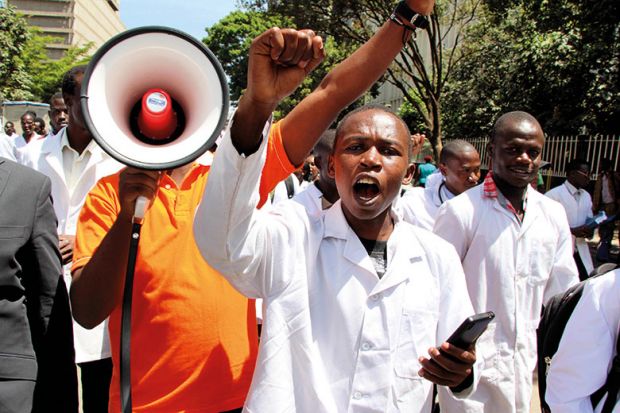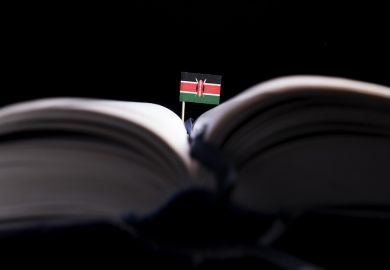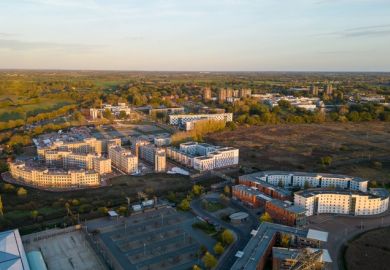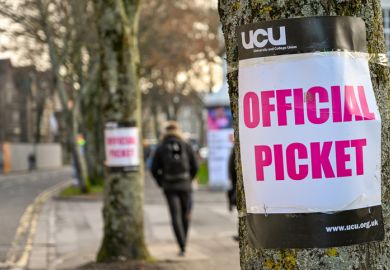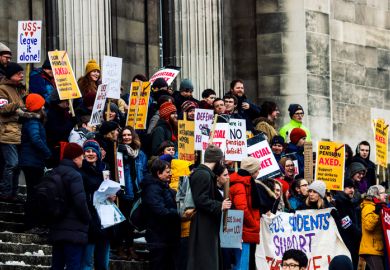For three months, Kenya’s public universities – usually sprawling campuses with thousands of students – have been little more than ghost towns.
Lectures have been cancelled and degrees have been put on hold while academics have been locked in a bitter dispute with the government over pay and benefits.
Finally, after a 77-day walkout, tutors are returning to work: in a press conference on 17 May, the Universities Academic Staff Union (UASU), which represents staff at 33 public universities, announced that it was ending the industrial action.
But the return to classes has been met with scepticism by students, who have grown used to their roller-coaster terms.
Kenya’s top public universities have been stuck in a relentless cycle of strikes, driven in recent years by the failure to resolve the collective bargaining agreements (CBA) that determine basic salaries, pay rises and other benefits.
The return-to-work agreement leaves lecturers no closer to negotiating the 2017-21 agreement, which should have been implemented last year. This makes the chances of another strike all the more likely, and a solution to finally breaking the vicious cycle all the more elusive.
For Ben Nyanchoga, professor of cultural tourism and archaeology at the University of Nairobi and a UASU chapter representative, the problem lies with the government not appreciating academics.
Basic monthly salaries range from $820 (£610) for lecturers to $2,500 (£1,860) for top professors. University staff also lack benefits such as healthcare, housing and care allowances enjoyed by other public servants.
That fact hit home for Dr Nyanchoga last month, when he couldn’t afford his son’s minor surgery and had to rely on his wife, who works at the Ministry of Education. “I’m a PhD holder in the university, [my wife’s] a clerk. But she must take care of the bills. What does that tell you?”
For others, the issue is poor management, since the Ministry of Education has little additional funding available to pay for salary increases.
“The problem is that the government’s planning doesn’t take [account of] the budgeting requirements for a CBA,” said Isaac Mbeche, deputy vice-chancellor of student affairs at Nairobi. “The workers will always want more and the government will always want less.”
This results in a situation in which pay and benefits must be debated afresh every four years in a complex series of negotiations that are conducted in an atmosphere of suspicion on both sides.
“Once we negotiate and agree, we’re not even certain it will be implemented. So it would call for another strike to be implemented,” said Constantine Wasonga, general secretary of UASU, who blamed universities for not implementing salary agreements.
Ishmael Munene, who researches African higher education at Northern Arizona University, argued that, to end the gridlock, basic salaries should be determined by the cost of living while pay rises should be evaluated on academic productivity and market value.
“[This would mean that] one can always get a raise without having to wait for collective bargaining, and then, when the government says they don’t have the money, there’s a strike,” he explained.
But why do recurring strikes, which aren’t limited to Kenya, occur in some African countries more than others?
According to Professor Munene, the answer lies in the numbers. Kenya's higher education system has grown rapidly in recent decades and, as of 2015, boasted 23 public universities, plus a further 47 colleges and private institutions. Professor Munene said that this meant more lecturers to pay and, because regulation has not been stringent enough, a declining reputation. Nigeria, which has more than 150 universities, regularly contends with strikes, said Professor Munene, who offered Uganda as a country that had protected the status of its top-tier institutions and was plagued less frequently by industrial unrest.
"Kenya needs a differentiated higher education system where we protect top-tier, especially older, universities,” Professor Munene argued.
In a country where demand for higher education is growing, that answer might not be satisfactory for students, whom everyone agrees are the ones hurt most by the strikes.
“It is disappointing, it’s very sad,” said Sharon Muyoke, a sociology student at Nairobi, who estimates that she is one year behind. “As a student, I ought to read and finish [my studies] and do other things. But now, due to the strike, I’m forced to wait and wait and wait.”
The consequences for students are serious, said Robinson Asman Omondi, chair of the students’ union at Jomo Kenyatta University of Agriculture and Technology. “This amount of idle time is what makes them engage in some things that are detrimental to their health. They’re having free time to engage in drug abuse,” he observed.
But, for students, strikes have become an unfortunate reality to attending public universities in Kenya.
“I think that there will be another strike next year. I think the problem is going to be there for our entire generation,” said Wallace Kabage, a second-year finance student at Nairobi.
POSTSCRIPT:
Print headline: Little hope as Kenyan lecturers’ strike ends
Register to continue
Why register?
- Registration is free and only takes a moment
- Once registered, you can read 3 articles a month
- Sign up for our newsletter
Subscribe
Or subscribe for unlimited access to:
- Unlimited access to news, views, insights & reviews
- Digital editions
- Digital access to THE’s university and college rankings analysis
Already registered or a current subscriber?
